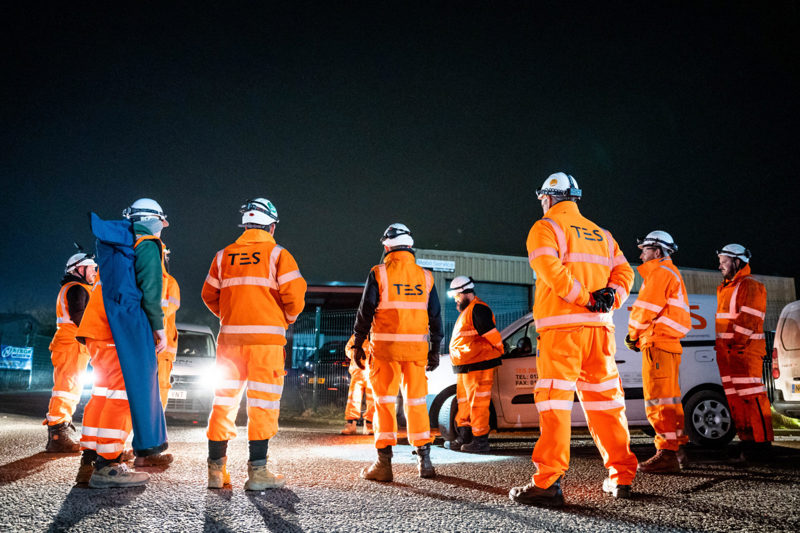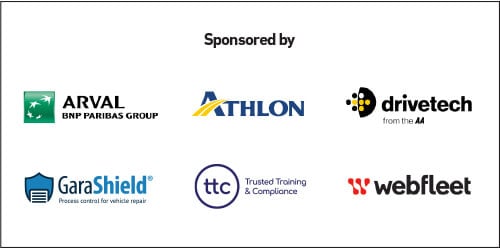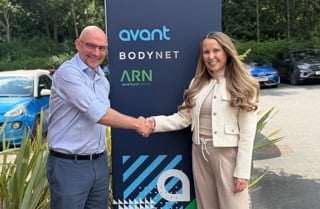This feature was taken from our special Running a Safe Fleet report.

Safety is a paramount priority in the rail industry. For TES 2000, safety is of equal importance when it comes to its vehicle fleet.
Due to its comprehensive risk management policy, the railway infrastructure and construction company, which has 140 vans, has had just five at-fault collisions in the past 12 months, with three of those involving animals.
Between 2020 and 2022, TES 2000 saw at-fault damage costs reduce by 60% while – despite rising fuel prices – overall costs for fuel fell by 20% and insurance premiums were cut by 20%.
A key part of its success is highlighting the human impact of road safety, with a first-hand experience of this beginning Mick Kiely’s journey as a fleet manager.
“I’ve been in the railway game now for 35 years, and I’ve been on the operational side as well,” he says.
“A friend of mine was killed in a collision 15 years ago when he was driving home from work. It wasn’t his fault; he was hit by two stolen cars that were speeding.
“I was also his ops manager, so I was called out and actually saw him in the vehicle.
“I had to speak to his family and it was an experience I never want to go through again.”
About a week later, Kiely started working with his employer’s fleet manager to raise awareness of – and to improve – fleet safety.
“That’s when I got introduced to telematics, and then I started looking at other things. I become aware of road safety charity Brake, and organisations like it, and started dedicating myself to fleet and then became a full-time fleet manager,” he says.
“One way or another, I said I’d make a difference. I’ve had some battles on the way, but we got there eventually.”
When Kiely, who was named road risk manager of the year at the UK Fleet Champions Awards in 2022, joined TES 2000 as its first professional fleet manager in 2020, one of his first actions was to analyse its existing fleet.
He found drivers routinely used company vehicles for personal journeys and banned this, introducing a policy of only clients and company employees being allowed in company vehicles.
Although there were objections from drivers, Kiely emphasised the vehicles were not insured to transport their families.
This change saw vehicles which covered 25,000 miles in 2019 reducing their annual mileage by more than half to 12,000. As well as cutting risk, this also significantly reduced fuel use.
Fleet optimisation
Kiely also reviewed the fleet size and was able to remove around 70 vehicles that were being underutilised.
He met with the company’s fleet insurers to examine TES 2000’s claims history and, after outlining his safety ambitions, received a significant contribution towards a risk management programme.
This allowed TES 2000 to bring in Red Fleet Driver Training’s e-learning solution, which creates a personal profile for each driver and provides access to a wide range of e-training modules.
A new employee’s fleet safety journey begins before they join the company. When they get an interview, TES 2000 carries out an online licence check.
“If they haven’t had their licence for more than two years, they are not driving a TES vehicle,” says Kiely. “If they have any points, I will look at the reason why they have them and if I approve that stage of it, I get Red Training to send them a link where they fill out a driver profile.
“Following that, they do some e-learning modules and I look at the results. It may be we judge they don’t need any more training at that point.
“If they do, I will get someone to take the driver out for an on-road assessment in the type of van they will be using.”
Employees who have had more than two collisions in a three-year period also undergo an on-road assessment, and then – if needed – will be put through an on-road training session.
They also have access to a driver app which contains the driver handbook, as well as being used to record their daily vehicle checks with a specific procedure that must be followed.
Defects reports automatically arrive on Kiely’s system and also go to the rental companies which supply TES 2000’s vehicles on flexible rental.
The app produces an electronic time stamp to show the daily check has been carried out and that the handbook has been read – this also features a timer to prevent drivers just flicking through and clicking confirm.
Constant reinforcement
It is also a key tool for reinforcing the safety message as it is used to send monthly toolbox talks on topics such as fatigue, speeding and driver distraction.
“We also send out a lot of hard-hitting videos in which people have lost relatives, especially children, in RTCs (road traffic collisions) and it hits home,” says Kiely.
“When you hear parents talking about how they lost their child because of a speeding driver and the effect it’s had on the whole family and community, it makes people think.”
The media sent out through the app is taken from the free resource library available through Driving for Better Business, and Kiely urges other fleet decision-makers to make the most of its vast library.
“I don’t understand why more companies are not using it. Not enough do,” he adds. “Every single thing is in there for a fleet manager to be legal and compliant. So why would you not use it? It doesn’t make sense.”
He says free resources are also available through FORS (the Fleet Operator Recognition Scheme), Brake and RoSPA (Royal Society for the Prevention of Accidents).
“Use them,” he adds. “If you use them, you’ll have no issues. That’s why my life is a lot easier.”
Kiely says it is vital for any organisation wanting to improve fleet safety to have buy-in from directors.
“If you don’t have their support, you’re banging your head against the wall,” he adds. “Unfortunately, there are a lot of people at the top that don’t know their responsibilities.”
This is more common at companies with a small number of vehicles which do not have full-time fleet managers, he says.
Kiely was recently at an event where driver safety expert Paul Ripley – the Driving Doctor – was speaking about corporate manslaughter and director responsibilities.
“I watched two directors from another company during it and they went ‘oh, f***’. They did not know; they didn’t have a clue,” he says.
Vehicle technology
All TES 2000 vehicles are fitted with telematics and dashcams to monitor driver behaviour. Exception reports are set up to notify Kiely of any risky incidents through email alerts.
Kiely spends each Monday analysing the data and, if needed, contacts drivers should they be driving poorly.
“I’ll invite them to come in for an informal chat and it’s a case of ‘if you don’t improve, the next one is disciplinary’. It works just by talking to someone.
“They don’t want the hassle of being brought in here and being spoken to. First, people can see them coming in and ask: ‘Oh, what’s he in there with Mick for?’ Second, their managers don’t want the hassle of me going to them and saying ‘I’m going to take the van off the employee if he doesn’t improve’.”
Employees are also incentivised to drive well through a rewards scheme which sees the top 12 drivers every quarter given £100.
Each December, those drivers’ names go into an annual draw, with four winners each receiving £250-worth of vouchers.
TES 2000 is in the process of replacing 30 of its diesel panel vans with petrol-hybrid Toyota Corolla Commercial models.
Given they are car-derived vans, they have a higher level of safety equipment as standard than traditional vans, including emergency steering assist, road sign assist and emergency driving stop.
They also have a speed limiter which can be set at different speeds. “It’s made a big difference,” says Kiely. “If I look at the telematics data I can see they are being driven at a constant 30mph in a 30mph zone and they never go over.
“As they’re petrol and run on electric when they’re going at less than 20mph, they’re saving us a lot of money when it comes to fuel as well.”
You could be forgiven for thinking that all fleet managers are interested in these days is electric vehicles: how to transition, charging, reimbursements and so on. Such discussion dominates opinion pieces, media column inches, social media discussion and even webinars.
Yes, it’s a juicy topic. No, it’s not what most fleet decision-makers are spending all their time thinking about.
This report on running a safe fleet looks at how to create a safety culture and implement a driver behaviour programme, as well as tackle root causes of accidents, in discussion with fleet leaders and industry experts with the sole purpose of helping you to deliver a robust risk and compliance policy, protecting both your staff and your business.























Login to comment
Comments
No comments have been made yet.